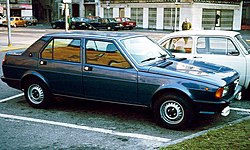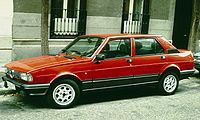Alfa Romeo Giulietta (Type 116)
| Alfa Romeo | |
|---|---|
|
Alfa Romeo Giulietta (1977-1983)
|
|
| Giulietta | |
| Production period: | 1977-1985 |
| Class : | Middle class |
| Body versions : | limousine |
| Engines: |
Otto engines : 1.3–2.0 liters (70–127 kW) Diesel engines : 2.0 liters (60 kW) |
| Length: | 4210 mm |
| Width: | 1650 mm |
| Height: | 1400 mm |
| Wheelbase : | 2510 mm |
| Empty weight : | 1070-1100 kg |
| Previous model | Alfa Romeo Giulia |
| successor | Alfa Romeo 75 |
The Giulietta is a mid-range four-door sedan from Alfa Romeo that was built from the summer of 1977 to the end of 1985. The type designation "Giulietta" has been used several times by Alfa Romeo over the years.
history
marketing
The Alfa Romeo Giulietta (Type 116) was presented in autumn 1977 as the successor to the Alfa Romeo Giulia .
The Giulietta design developed by Ermanno Cressoni in Alfa Romeo's Centro Stile was heavily criticized; it was one of the reasons for the decline of the brand and for falling sales figures in Germany.
“It was also fatal that it was not possible to develop a suitable successor for Romeo's beloved [Giulia]. Poor Julchen was really not built to inflame buyers' hearts. The engineers had given the Giulietta a bonnet that aroused the suspicion that it came from the same press as the Thuringian biscuit tin called Wartburg. The rear looks like someone picked up the car and never let it go. The view to the rear was poor, the trunk too small. "
Facelift
In autumn 1983 the series was revised in many details.
At the end of 1985 the production of the Giulietta ran out. It was replaced by the technically identical Alfa Romeo 75 .
construction
technology
Technically it was largely the same as the Alfa Romeo Alfetta presented in spring 1972 , that is, both vehicle series shared the floor pan , the engine and drive concept. The Giulietta was a bit shorter and wider with the same wheelbase. The so-called transaxle drive was characteristic, with the engine at the front, the clutch, the gearbox and the differential on the driven rear axle. The resulting even weight distribution gave the vehicle good driving characteristics. This engine-transmission arrangement was still used in the middle class in the Volvo models ( Volvo 340/360 ) from DAF ; In the long term, however, it was only able to establish itself in sports cars. Otherwise, the chassis offered double wishbones at the front, a rigid De-Dion axle at the rear guided on an A-shaped drawbar and a Watt linkage , disc brakes (on the inside at the rear) and rack and pinion steering.
design
The exterior of the Giulietta looked strange to many contemporaries. Its shape was no less independent and shaped by aerodynamics than that of the Giulia, but completely different. With a flat bow, a rising sideline and a high stern, the designers had created a pronounced wedge shape. The trunk lid ran horizontally and ended in a pronounced spoiler lip. The height of the rear was emphasized by the fact that the rear lights were moved to its upper edge and the design of the rear view was subtle.
Considered three decades apart, the design of the vehicle anticipated many elements of the vehicle design that are now standard in sedan design, for example the flat front and high rear.
variants
During its production time, the Giulietta was available with a large number of engine and equipment variants: There were engines with a displacement of 1.3, 1.6, 1.8 and up to 2.0 liters. The model from the last series was also available as a turbo version, which was produced 361 times. Two pre-series prototypes of the second series never left the factory.
The turbocharged 2-liter engine of the Turbo Autodelta developed 170 hp (125 kW) and helped the car achieve high performance. The Alfa Romeo racing department "Autodelta" worked on the homologation project for racing purposes. With the elimination of "Autodelta" and the prospect of the Alfa 75, the project was canceled. It would have been the last car developed by “Autodelta”.
Web links
- 30 years of Nuova Giulietta. Alfaclub Germany, accessed on March 12, 2015 .
- Tungsten Nickel: Alfa Romeo Giulietta. A strange looking wedge from Italy. In: PS World. Welt Online , November 21, 2017, accessed December 9, 2017 .
Individual evidence
- ↑ a b Poor Julchen . In: Der Spiegel . No. 46 , 1981, pp. 274-276 ( online ). Quote: “Is Alfa Romeo's good reputation finally gone? Italy's upmarket car company is threatened with new record losses. "
| Timeline of Alfa Romeo models from 1945 to today | ||||||||||||||||||||||||||||||||||||||||||||||||||||||||||||||||||||||||||||
|---|---|---|---|---|---|---|---|---|---|---|---|---|---|---|---|---|---|---|---|---|---|---|---|---|---|---|---|---|---|---|---|---|---|---|---|---|---|---|---|---|---|---|---|---|---|---|---|---|---|---|---|---|---|---|---|---|---|---|---|---|---|---|---|---|---|---|---|---|---|---|---|---|---|---|---|---|
| Type | Independent until 1933, then state-owned | from 1986 part of Fiat | ||||||||||||||||||||||||||||||||||||||||||||||||||||||||||||||||||||||||||
| 1940s | 1950s | 1960s | 1970s | 1980s | 1990s | 2000s | 2010s | 2020s | ||||||||||||||||||||||||||||||||||||||||||||||||||||||||||||||||||||
| 5 | 6th | 7th | 8th | 9 | 0 | 1 | 2 | 3 | 4th | 5 | 6th | 7th | 8th | 9 | 0 | 1 | 2 | 3 | 4th | 5 | 6th | 7th | 8th | 9 | 0 | 1 | 2 | 3 | 4th | 5 | 6th | 7th | 8th | 9 | 0 | 1 | 2 | 3 | 4th | 5 | 6th | 7th | 8th | 9 | 0 | 1 | 2 | 3 | 4th | 5 | 6th | 7th | 8th | 9 | 0 | 1 | 2 | 3 | 4th | 5 | 6th | 7th | 8th | 9 | 0 | 1 | 2 | 3 | 4th | 5 | 6th | 7th | 8th | 9 | 0 | |
| Small car | MiTo (955) | |||||||||||||||||||||||||||||||||||||||||||||||||||||||||||||||||||||||||||
| Compact class | Arna | |||||||||||||||||||||||||||||||||||||||||||||||||||||||||||||||||||||||||||
| Alfasud | 33 | 145 , 146 (930) | 147 (937) | Giulietta (940) | ||||||||||||||||||||||||||||||||||||||||||||||||||||||||||||||||||||||||
| Middle class | Giulietta Berlina | Giulia | Giulietta (type 116) | 75 | 155 | 156 (932) | 159 (939) | Giulia (952) | ||||||||||||||||||||||||||||||||||||||||||||||||||||||||||||||||||||
| upper middle class | Alfetta | 90 | 164 | 166 (936) | ||||||||||||||||||||||||||||||||||||||||||||||||||||||||||||||||||||||||
| ... | 6C 2500 | 1900 Berlina | 2000 Berlina | 2600 Berlina | 1750/2000 Berlina | Alfa 6 | ||||||||||||||||||||||||||||||||||||||||||||||||||||||||||||||||||||||
| Coupe | Giulietta Sprint | Giulia Sprint GT | Alfasud Sprint | GT (937) | ||||||||||||||||||||||||||||||||||||||||||||||||||||||||||||||||||||||||
| 1900C sprint / super sprint | 2000 sprint | 2600 sprint | 1750/2000 GT Veloce | Alfetta GT / GTV | GTV (916) | Brera (939) | ||||||||||||||||||||||||||||||||||||||||||||||||||||||||||||||||||||||
| Cabriolet | Giulietta Spider | Giulia Spider | Spider ("Duetto") | Spider (916) | Spider (939) | |||||||||||||||||||||||||||||||||||||||||||||||||||||||||||||||||||||||
| 2000 spider | 2600 spider | |||||||||||||||||||||||||||||||||||||||||||||||||||||||||||||||||||||||||||
| Sports car | Disco Volante | Tipo 33 | Montreal | SZ / RZ | 8C Competizione | 4C | ||||||||||||||||||||||||||||||||||||||||||||||||||||||||||||||||||||||
| Off-road vehicle and SUV | Matta | Stelvio (949) | ||||||||||||||||||||||||||||||||||||||||||||||||||||||||||||||||||||||||||
| Vans | Romeo | F12 / A12 | AR6 | |||||||||||||||||||||||||||||||||||||||||||||||||||||||||||||||||||||||||
| AR8 | ||||||||||||||||||||||||||||||||||||||||||||||||||||||||||||||||||||||||||||
|
|
||||||||||||||||||||||||||||||||||||||||||||||||||||||||||||||||||||||||||||




